#Intelligent service robots
Explore tagged Tumblr posts
Text
Application Solutions for Intelligent Service Robots Based on the FET3588J-C Main Control Platform
An intelligent service robot is a robot that integrates advanced technologies such as artificial intelligence, perception technology, and machine learning. Its purpose is to provide a variety of services and support to meet the needs of people in daily life, business, and industrial fields. These robots can sense the environment, understand speech and images, perform tasks, and interact naturally and intelligently with human users.
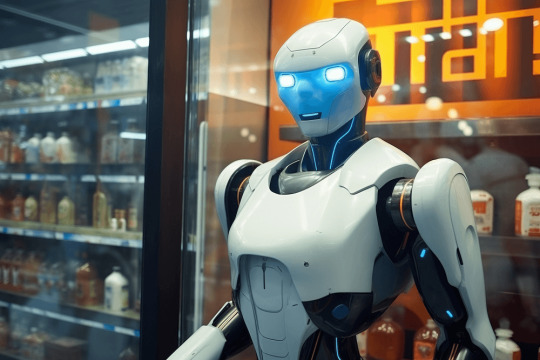
Areas of Application:
Business Services: It includes services such as reception, shopping assistance, and information inquiry, and can be used in places such as shopping malls, hotels, and exhibitions.
Health Care: It provides services such as drug delivery, patient companionship and health monitoring for hospitals and nursing homes.
Educational Assistance: It is used in educational scenarios to provide auxiliary teaching, answering questions and other services.
Family Services: Provide cleaning, handling, home control and other services to improve the quality of life.
The hardware structure of the service robot includes several key components. The functions and roles of these hardware components are as follows:
Controls: As the core of the robot, the control device is responsible for receiving and processing the data provided by the sensors, executing the corresponding algorithms, and issuing instructions to the driving device to achieve the various functions of the robot. High-performance, low-power ARM chips are often chosen for the control unit, ensuring that the robot has sufficient computational and storage capacity.
Drive unit: This includes motors and drivers, which are used to execute the motion and action commands of the robot. The motor is responsible for providing power, while the driver converts electronic signals into mechanical motion. This part is the motion system of the robot, which determines the execution of actions such as walking, turning, and the mechanical arm.
Camera: As the ''eyes'' of the robot, the camera is used to capture images and facial information of the external environment. These image data can be used for tasks such as environmental perception, navigation, target recognition, allowing the robot to better understand and adapt to the surrounding environment.
Sensors: Sensors provide the robot with various perceptual abilities, including vision, touch, hearing, and distance sensing, among others. Angle sensors and current sensors reflect the robot's own state, while temperature sensors, laser sensors, ultrasonic sensors, infrared sensors, etc. are used to collect external environmental information, allowing the robot to perceive and understand the surrounding situation more comprehensively.
Display and Audio: As an important part of human-computer interaction, display and audio devices realize the presentation and interaction of user interface. The touch display provides an intuitive graphical user interface, while the voice interaction system enables the robot to understand the user's instructions and respond accordingly, thus better communicating with the human user.
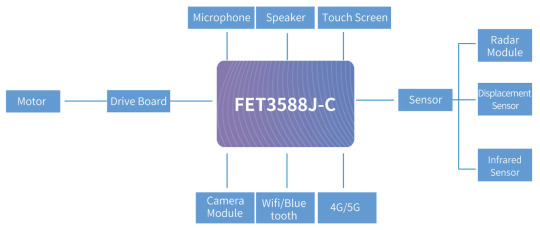
Folinx Embedded has launched the FET3588J-C SoM as the main control platform for this intelligent inspection robot product to meet customers' needs for machine vision and high-speed interfaces.
FET3588J-C SoM is developed and designed based on Rockchip's RK3588 processor, integrating Cortex-A74-core-6 + 4-core Cortex-A55 architecture. The main frequency of A76 core is up to 2.4GHz, and the main frequency of A55 core is up to 1.8GHz, which can efficiently process the information collected by patrol inspection;
The built-in NPU with comprehensive computing power of up to 6 TOPS greatly improves the calculation speed and energy efficiency of neural networks,providing robots with powerful AI learning and edge computing capabilities, enabling them to intelligently adapt to different work scenarios.
RK3588J supports a 48-megapixel ISP3.0, which enables lens shading correction, 2D/3D noise reduction, sharpening and haze removal, fish eye correction, gamma correction, wide dynamic range contrast enhancement, and other effects. This significantly enhances the image quality.
With abundant interface resources, it meets the robot's access requirements for various sensors. More sensor access helps the device to collect environment data more comprehensively. This platform also supports external storage interfaces such as SATA3.0, USB3.0, allowing data to be locally stored. It also supports wireless communication methods such as WiFi, 4G, and 5G, making it convenient for users to query device information on mobile devices. The rich functionality enables robots to perceive and understand the surrounding environment more comprehensively.
It also has high stability. The platform’s SoM has undergone rigorous environmental temperature and pressure tests, and can operate for long periods in harsh industrial environments ranging from -40°C to +85°C, adapting to applications in various scenarios.
Originally published at www.forlinx.net.
0 notes
Text



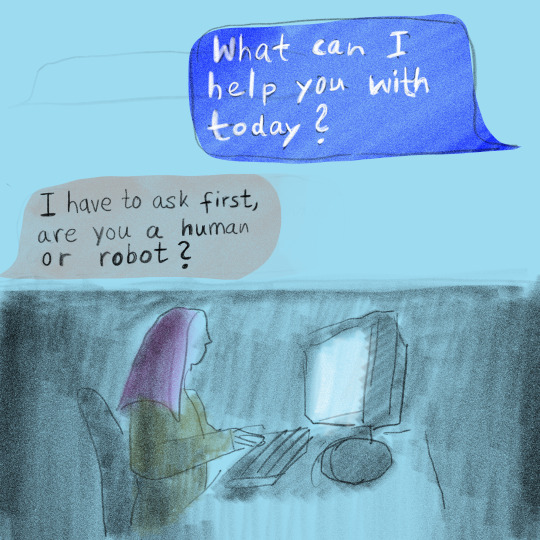





Human or robot | Real story from working in customer support
#art#artists on tumblr#webcomic#mini comic#annatish#anna tishchenko#customer service#cyborg#cybernetics#ghost in the shell#drawing#short story#robot#dystopia#artificial intelligence#customer support#funny
116 notes
·
View notes
Text
AI & Machine Learning Services: Driving Innovation in Business
In today’s fast-paced digital world, AI and Machine Learning (ML) are revolutionizing industries across the globe. These technologies are no longer futuristic concepts but integral parts of modern business operations. From automating routine tasks to making data-driven decisions, AI and ML are transforming how companies operate, innovate, and compete.
Why AI & Machine Learning Matter
AI and ML empower businesses to process massive amounts of data quickly and accurately, uncovering patterns and insights that would otherwise remain hidden. This capability opens the door to smarter decision-making, predictive analytics, and automation of tasks that previously required human intervention. In industries such as healthcare, finance, retail, and manufacturing, AI and ML are enhancing efficiency, reducing costs, and enabling personalization at scale.
For example, in retail, AI-driven recommendation systems help businesses offer personalized product suggestions to customers, boosting engagement and sales. In healthcare, machine learning algorithms analyze medical data to assist in diagnosing diseases earlier and more accurately. These applications are just the beginning—AI and ML can be tailored to meet the specific needs of almost any industry.
The Role of Gravity in AI & ML Services
At Gravity Engineering, we understand the transformative potential of AI and ML and are committed to helping businesses harness these technologies to their fullest potential. Our AI & Machine Learning services are designed to address the unique challenges of our clients, offering customized solutions that drive innovation, efficiency, and growth.
We assist businesses by implementing AI and ML solutions that automate processes, improve decision-making, and uncover actionable insights from complex data. Whether it's predictive modeling, natural language processing, or computer vision, we leverage advanced algorithms to solve real-world problems. At Gravity, we also ensure that our solutions are easy to integrate with existing systems, minimizing disruption while maximizing impact.
Our expertise extends across industries, from streamlining supply chains to enhancing customer experiences. By working with Gravity, businesses gain a competitive edge through smart technologies that enable them to stay ahead in an ever-evolving market.
Unlocking New Opportunities
AI and Machine Learning are more than just tools; they represent a new era of possibilities for businesses. By embracing these technologies, companies can innovate faster, make smarter decisions, and unlock new revenue streams. At Gravity, we believe in the power of AI to create a better future, not just for businesses, but for society as a whole.
In partnering with Gravity, businesses are not just adopting new technologies; they are investing in a strategic partner that understands the “gravity” of change and is dedicated to helping them thrive in this AI-driven world.
#business#ecommerce#website#artificial intelligence#machinelearning#robotics#cloudcomputing#marketing#services
2 notes
·
View notes
Text
Inside the AI Based Contact Center with Tools Tech and Trends
Introduction

The evolution of customer service has entered a new era with the rise of the AI based contact center. No longer just a support line, today’s contact centers are intelligent, data-driven hubs that utilize artificial intelligence to deliver personalized, efficient, and scalable customer interactions. As businesses race to stay ahead of the curve, understanding the essential tools, technologies, and emerging trends that power AI-driven contact centers becomes crucial. This article explores how AI is transforming contact centers and what lies ahead for this innovative landscape.
The Rise of the AI Based Contact Center
Traditional contact centers, though essential, have long suffered from inefficiencies such as long wait times, inconsistent service, and high operational costs. AI-based contact centers are solving these issues by automating routine tasks, predicting customer needs, and delivering omnichannel support.
AI technology, such as machine learning, natural language processing (NLP), and robotic process automation (RPA), is now integrated into contact center platforms to enhance agent productivity and customer satisfaction.
Essential Tools Driving AI Based Contact Centers
1. AI-Powered Chatbots and Virtual Agents
Chatbots are the most visible AI tool in contact centers. These virtual assistants handle customer queries instantly and are available 24/7. Advanced bots can handle complex conversations using NLP and deep learning, reducing human intervention for repetitive inquiries.
2. Intelligent Interactive Voice Response (IVR) Systems
Modern IVR systems use voice recognition and AI to route calls more accurately. Unlike traditional menu-based IVRs, intelligent IVRs can interpret natural language, making customer interactions smoother and faster.
3. Speech Analytics Tools
AI-driven speech analytics tools analyze live or recorded conversations in real time. They extract keywords, sentiments, and emotional cues, offering insights into customer satisfaction, agent performance, and compliance issues.
4. Workforce Optimization (WFO) Platforms
AI helps optimize staffing through forecasting and scheduling tools that predict call volumes and agent availability. These platforms improve efficiency and reduce costs by aligning workforce resources with demand.
5. CRM Integration and Predictive Analytics
By integrating AI with CRM systems, contact centers gain predictive capabilities. AI analyzes customer data to forecast needs, recommend next-best actions, and personalize interactions, leading to higher engagement and retention.
Core Technologies Enabling AI Based Contact Centers
1. Natural Language Processing (NLP)
NLP allows machines to understand, interpret, and respond in human language. This is the backbone of AI-based communication, enabling features like voice recognition, sentiment detection, and conversational AI.
2. Machine Learning and Deep Learning
These technologies enable AI systems to learn from past interactions and improve over time. They are used to personalize customer interactions, detect fraud, and optimize call routing.
3. Cloud Computing
Cloud platforms provide the infrastructure for scalability and flexibility. AI contact centers hosted in the cloud offer remote access, fast deployment, and seamless integration with third-party applications.
4. Robotic Process Automation (RPA)
RPA automates repetitive tasks such as data entry, ticket generation, and follow-ups. This frees up human agents to focus on more complex customer issues, improving efficiency.
Emerging Trends in AI Based Contact Centers
1. Hyper-Personalization
AI is pushing personalization to new heights by leveraging real-time data, purchase history, and browsing behavior. Contact centers can now offer customized solutions and product recommendations during live interactions.
2. Omnichannel AI Integration
Customers expect consistent service across channels—phone, email, chat, social media, and more. AI tools unify customer data across platforms, enabling seamless, context-aware conversations.
3. Emotion AI and Sentiment Analysis
Emotion AI goes beyond words to analyze voice tone, pace, and volume to determine a caller's emotional state. This data helps agents adapt their responses or triggers escalations when needed.
4. Agent Assist Tools
AI now works hand-in-hand with human agents by suggesting responses, summarizing calls, and providing real-time knowledge base access. These agent assist tools enhance productivity and reduce training time.
5. AI Ethics and Transparency
As AI becomes more prevalent, companies are increasingly focused on responsible AI usage. Transparency in how decisions are made, data privacy, and eliminating bias are emerging priorities for AI implementation.
Benefits of Adopting an AI Based Contact Center
Businesses that adopt AI-based contact centers experience a variety of benefits:
Improved Customer Satisfaction: Faster, more accurate responses enhance the overall experience.
Cost Reduction: Automation reduces reliance on large human teams for repetitive tasks.
Increased Scalability: AI can handle spikes in volume without compromising service quality.
Better Insights: Data analytics uncover trends and customer behaviors for better strategy.
Challenges in AI Based Contact Center Implementation
Despite the advantages, there are challenges to be aware of:
High Initial Investment: Setting up AI tools can be capital intensive.
Integration Complexities: Integrating AI with legacy systems may require customization.
Change Management: Staff may resist AI adoption due to fear of replacement or complexity.
Data Security and Compliance: AI systems must adhere to data protection regulations like GDPR or HIPAA.
Future Outlook of AI Based Contact Centers
The future of AI-based contact centers is promising. As technology matures, we can expect deeper personalization, more intuitive bots, and stronger collaboration between human agents and AI. Voice AI will become more empathetic and context-aware, while backend analytics will drive strategic decision-making.
By 2030, many experts predict that AI will handle the majority of customer interactions, with human agents stepping in only for high-level concerns. This hybrid model will redefine efficiency and service quality in the contact center industry.
Conclusion
The AI based contact center is transforming how businesses interact with customers. With powerful tools, cutting-edge technologies, and evolving trends, organizations are reimagining the contact center as a strategic asset rather than a cost center. By investing in AI, companies can enhance customer experiences, improve operational efficiency, and stay competitive in an increasingly digital marketplace. The time to explore and adopt AI contact center solutions is now—because the future of customer support is already here.
#AI based contact center#contact center tools#AI contact center technology#artificial intelligence in customer service#customer service automation#chatbot integration#virtual agents#intelligent IVR systems#speech analytics#workforce optimization#predictive analytics in contact centers#CRM integration with AI#natural language processing#machine learning in call centers#robotic process automation#omnichannel support#emotion AI#agent assist tools#contact center trends#AI-powered customer experience
0 notes
Text
Explore the Development and Application of AI-Powered Robots

Artificial Intelligence (AI) has transcended its conceptual origins and found real-world expression in the form of AI-powered robots—machines that can see, think, decide, and act. From autonomous delivery drones and surgical robots to smart assistants and industrial cobots, these intelligent machines are transforming how we live, work, and interact.
At the forefront of this revolution are firms like ours—an AI development company in New York—pushing boundaries and redefining what robots can do with the power of AI. In this blog, we’ll explore the exciting development and multifaceted applications of AI-powered robots, along with the technologies driving their evolution.
Understanding AI-Powered Robots
AI-powered robots are machines that combine robotics with artificial intelligence to perform tasks that typically require human intelligence. These robots leverage AI techniques such as:
Machine Learning
Natural Language Processing (NLP)
Computer Vision
Sensor Fusion
Decision Algorithms
An AI developer in New York typically integrates these technologies to give robots the ability to perceive their environment, make decisions, and learn from experience—much like a human.
Evolution of AI Robots: From Rule-Based to Autonomous Systems
The first wave of robotics was rule-based and inflexible. These early robots could only perform tasks they were explicitly programmed for, making them suitable for repetitive jobs like welding on assembly lines.
With the rise of machine learning, robotics entered a new era. Today’s AI-powered robots can adapt to new situations, learn from human behavior, and even engage in complex decision-making. An artificial intelligence development company in New York typically builds robots that integrate cloud-based learning, real-time analytics, and sensor-driven feedback loops.
Key Components in the Development of AI Robots
Creating an AI-powered robot involves the integration of multiple disciplines. Here’s how a modern AI development company in New York approaches the process:
1. Sensing and Perception
Robots use computer vision, LIDAR, ultrasonic sensors, and thermal imaging to "see" and understand their environment. Computer vision algorithms can recognize objects, faces, gestures, and terrain.
2. Natural Language Processing (NLP)
NLP allows robots to understand and respond to human language, both written and spoken. Think of customer service bots or robotic assistants like Pepper or Sophia.
3. Machine Learning Models
Robots use ML algorithms to learn from past data and improve their performance. Whether it's recognizing speech patterns or optimizing routes in a warehouse, learning is central to autonomy.
4. Control Systems and Actuators
These translate AI-generated decisions into physical actions. For example, when a service robot decides to fetch an item, its control system sends signals to motors and joints to execute the task.
5. Edge and Cloud Computing
While some decisions are made on-board, complex processing is often outsourced to the cloud. Many AI development services in New York design hybrid systems that balance local autonomy with cloud-based intelligence.
Applications of AI-Powered Robots Across Industries
1. Healthcare
Surgical Robots: Enhance precision and reduce patient recovery time.
Companion Robots: Support elderly care with medication reminders and emotional companionship.
Sanitization Bots: Disinfect hospitals using UV light, reducing the spread of infections.
An AI development company in New York may work with healthcare providers to build HIPAA-compliant robots for telemedicine and diagnostics.
2. Retail and Hospitality
Service Robots: Greet customers, answer queries, and guide them through stores.
Inventory Robots: Scan shelves and update stock in real-time.
Room Service Robots: Deliver orders in hotels with precision and speed.
AI robots built by AI development companies in New York are already active in flagship hotels and retail outlets across Manhattan.
3. Manufacturing and Warehousing
Collaborative Robots (Cobots): Work safely alongside human workers.
Inspection Bots: Use vision systems to detect defects on the assembly line.
Logistics Bots: Navigate through warehouses to transport items efficiently.
These systems rely on AI for pathfinding, object detection, and productivity optimization.
4. Agriculture
Crop Monitoring Bots: Analyze soil conditions, water levels, and plant health.
Harvesting Robots: Pick fruit or vegetables based on ripeness detected by AI.
Drones: Spray pesticides or seed fields with precision.
The demand for agricultural robotics has led several AI development companies in New York to collaborate with agri-tech startups.
5. Public Safety and Defense
Surveillance Robots: Patrol areas and detect unusual activities.
Rescue Bots: Navigate through disaster zones to locate and rescue victims.
Explosive Ordinance Disposal (EOD) Robots: Handle hazardous materials remotely.
These use AI to process data in real-time and make life-saving decisions under pressure.
Challenges in AI Robotics Development
Even the best AI development companies in New York face hurdles in the creation of reliable AI robots:
Ethical Concerns: Autonomous decision-making must be aligned with human values and legal frameworks.
Hardware Constraints: Power consumption, battery life, and physical durability limit design options.
Data Privacy: Robots that gather and process data (especially personal data) must comply with strict privacy laws.
Cost of Development: Building intelligent robots requires significant investment in both hardware and software.
Overcoming these requires not just technical expertise but also cross-functional collaboration, an area where a seasoned artificial intelligence development company in New York truly adds value.
The Role of AI Development Services in New York
AI-powered robots aren’t built in a vacuum. They rely on strong partnerships and innovative ecosystems. Here's how AI development services in New York contribute:
Prototype to Production: Transforming concepts into fully functional robotic solutions.
Custom AI Integration: Developing tailored algorithms for niche use-cases.
Cloud Infrastructure: Integrating AWS, Azure, or GCP for real-time data processing.
Continuous Learning: Training robots to improve through user interaction and feedback.
As one of the most tech-forward cities in the world, New York is home to some of the most dynamic AI development companies—each playing a crucial role in shaping the future of robotics.
What the Future Holds
The future of AI-powered robotics is full of promise:
Emotionally Intelligent Robots: Capable of interpreting and responding to human emotions.
Self-Healing Bots: Systems that can diagnose and repair their own issues.
Swarm Robotics: Coordinated fleets of mini robots working as one intelligent system.
Fully Autonomous Vehicles: Merging robotics with transport, transforming logistics and commuting.
Leading AI developers in New York are already experimenting with many of these concepts, pushing boundaries and exploring new frontiers.
Final Thoughts
AI-powered robots are no longer the stuff of science fiction. They’re active participants in modern industries—from healthcare and hospitality to manufacturing and public safety. As these systems become smarter and more autonomous, they will transform how businesses operate and how we live our daily lives.
For companies looking to embrace this transformative wave, choosing the right technology partner is crucial. As a trusted AI development company in New York, we help clients conceptualize, build, and scale AI-powered robots that deliver real-world impact.
Whether you’re exploring automation for your warehouse, robotic assistants for your healthcare facility, or AI bots for smart city initiatives—we’re here to help bring your vision to life.
Lear more https://winklix.wixsite.com/winklix/single-post/how-small-businesses-can-leverage-ai-for-growth
#ai development company in new york#ai developer in new york#artificial intelligence development company in new york#ai development services in new york#ai development companies in new york#Explore the Development and Application of AI-Powered Robots
0 notes
Text
Dark Factories and the Future of Work: How AI-Driven Automation is Reshaping Manufacturing
New Post has been published on https://thedigitalinsider.com/dark-factories-and-the-future-of-work-how-ai-driven-automation-is-reshaping-manufacturing/
Dark Factories and the Future of Work: How AI-Driven Automation is Reshaping Manufacturing
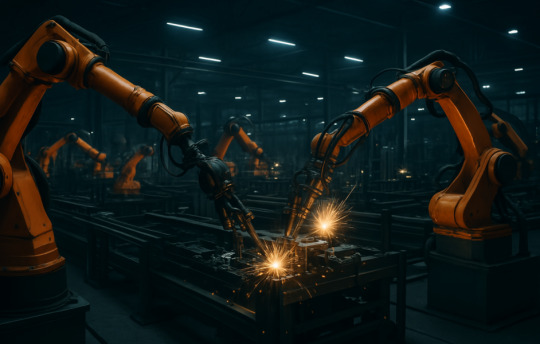

In today’s fast-changing industrial world, AI-driven automation is no longer just a part of the future; it is happening right now. One of the most notable examples of this transformation is the rise of dark factories in China. These advanced factories operate entirely without human workers and even without traditional lighting. Instead, they rely on robotics and artificial intelligence to run 24/7.
Companies like Xiaomi are at the forefront of this transformation, advancing manufacturing efficiency and precision to new levels. However, as this technology continues to grow, it raises crucial questions about the future of work, the potential for job displacement, and how societies will adapt to this new approach to production.
What Are Dark Factories?
A dark factory is a fully automated production facility without human workers. The term dark factory originates from the fact that these facilities do not require traditional lighting since no humans are on the factory floor. Instead, advanced machines, AI systems, and robotics manage every aspect of production, including assembly, inspection, and logistics. This setup eliminates human error, reduces labor costs, and allows continuous operation without breaks or fatigue.
Xiaomi’s smart factory in Changping exemplifies this new manufacturing paradigm in China. The factory produces one smartphone per second using AI and robotics to achieve exceptional efficiency and precision. Xiaomi invested approximately $330 million in this facility, which spans 81,000 square meters and has an annual production capacity of 10 million devices. The factory integrates self-developed AI systems for real-time monitoring and automated maintenance, such as dust removal.
China’s broader advancement toward automation aligns with its Made in China 2025 strategy, which aims to establish the country as a global leader in high-tech manufacturing. In 2022 alone, China installed 290,367 industrial robots, accounting for 52% of the worldwide total, according to the International Federation of Robotics (IFR). This reflects China’s commitment to leveraging AI and robotics to transform its manufacturing sector.
In China, the rise of dark factories powered by automation and artificial intelligence revolutionizes manufacturing processes and supports China’s broader environmental goals. Integrating AI and robotics in these factories is expected to enhance energy efficiency significantly. Automation helps streamline operations, reducing the need for human-centric infrastructure like lighting, heating, and break areas, ultimately leading to lower energy consumption. This aligns with China’s carbon neutrality goals for 2060, as automation in industrial settings is a key factor in improving overall energy efficiency across sectors.
The Rise of AI-Driven Automation in China
China has become a global leader in industrial automation, driven by its efforts to adopt advanced technologies like AI, robotics, and smart manufacturing. The government invests heavily in these areas to boost the country’s manufacturing power and stay competitive in a fast-changing global market.
As of 2023, China’s robot density reached 470 robots per 10,000 manufacturing workers, significantly higher than the global average of 162 robots per 10,000 employees. Companies like Foxconn and BYD are leading this transformation. For example, Foxconn replaced 60,000 workers with robots in its factory in Kunshan in 2016 and has already automated 30% of its operations. Likewise, BYD, a major electric vehicle manufacturer, uses robots to assemble EV batteries and chassis in its factories in Shenzhen and Xi’an.
This shift is supported by significant government investment. In 2023 alone, China spent $1.4 billion on robotics research and development, accelerating its move toward automation.
However, the rapid adoption of automation raises concerns, especially about job losses. Manufacturing currently employs over 100 million people in China, and many of these jobs could be replaced by robots. A report from Oxford Economics in 2017 predicted that 12 million manufacturing jobs in China could be lost to robots by 2030. This brings a big challenge, as many workers may not have the skills to transition into new roles in the evolving economy.
Adapting to the Future of Work: The Impact of AI-Driven Automation on Jobs
Dark factories are quickly becoming one of the most noticeable signs of AI-driven automation, where human workers are replaced entirely by machines and AI systems. These fully automated factories operate 24/7 without lighting or human intervention and are transforming industries globally. Although China has taken the lead in implementing dark factories, this transformation is happening worldwide in electronics, automotive manufacturing, and customer service. Companies like Xiaomi and Foxconn use AI and robotics to improve efficiency, reduce labor costs, and run operations continuously without human workers.
One of the most significant consequences of this automation is job displacement. Many manufacturing, logistics, and customer service workers are at risk of losing their jobs as machines take over tasks once done by humans. The World Economic Forum predicts that by 2027, up to 83 million jobs could be lost to automation, particularly in assembly lines and warehouses.
While automation is eliminating some jobs, it is also creating new opportunities. Roles in AI programming, robotics maintenance, and data analysis are expected to grow. The World Economic Forum forecasts that by 2027, 69 million new jobs will be created in areas like green energy and technology. However, the key challenge is ensuring workers transition into these new roles. This will require significant investments in education and retraining programs to help workers gain the skills they need for an AI-driven economy.
One of the biggest challenges in this transition is the skills gap. As automation grows, many workers must be retrained for new roles. For instance, jobs that require physical labor will be replaced by machines, while jobs that need creativity, problem-solving, and technical expertise will become more critical. To ensure that workers can succeed, businesses and governments must invest in training programs to help them acquire these new skills.
Looking ahead, the future of work will likely involve humans and machines working together. Robots and AI will handle repetitive tasks, but humans will still be needed for jobs that require creativity, emotional intelligence, and decision-making. Governments and businesses must focus on education and training programs that help workers learn to collaborate with AI to ensure a smooth transition to this new way of working. Investing in these programs ensures that workers are ready for the changes and can thrive in an AI-driven economy.
The Bottom Line
AI-driven automation is transforming the manufacturing industry, especially in China’s dark factories. While these advancements offer significant gains in efficiency and cost reduction, they raise important concerns about job displacement, skills gaps, and social inequality. As automation continues to grow, it will be essential for businesses, governments, and workers to work together to find solutions that ensure the benefits are shared fairly.
The future of work will require a balance between technological progress and human potential. By focusing on reskilling workers, promoting AI ethics, and encouraging collaboration between humans and machines, we can ensure that automation enhances human labor rather than replaces it.
#000#2022#2023#2025#accounting#adoption#ai#ai automation#AI Ethics#AI systems#Analysis#approach#artificial#Artificial Intelligence#automation#automotive#autonomous robots#batteries#billion#carbon#challenge#China#China AI advancements#collaborate#Collaboration#Companies#continuous#creativity#customer service#Dark
0 notes
Text
International Businesses: Navigate Global Shipping with Arihant's Expertise

The future of courier services is here! Explore key trends like AI-driven logistics, drone delivery, sustainability, and hyper-personalization shaping package delivery in 2025 and beyond. Learn how businesses can adapt and thrive in this tech-driven world.
#future of courier services#courier services 2025#delivery services#package delivery#logistics#automation#robotics#drones#AI#artificial intelligence#machine learning#sustainability#green logistics#electric vehicles#last-mile delivery#blockchain#internet of things (IoT)#augmented reality (AR)#same-day delivery#predictive analytics#supply chain#e-commerce delivery#delivery trends#courier industry trends#logistics trends#emerging technologies#delivery innovation#shipping#global shipping#international shipping
0 notes
Text

#RPA#Intelligent Automation#Automation Services#Automation Company#Dubai#centelli#UAE#Hire RPA#Robotic Process Automation
0 notes
Text
Dogs: Mankind's Evolutionary Partner for All Time
Your dog is more than a pet, companion or best friend. He or she is your evolutionary partner in a conjunctive venture stretching over millennia through glaciers, floods, pestilence, famine, war, migration and domestication. Humans and wolves share history as carnivores hunting in packs for food. When early man discovered fire, wolves ventured into their camps for meat scraps and warmth. A…
#Artificial Intelligence#Best friends#Cats#Dog distress#Dogs#Emotional support dogs#Evolutionary partners#Lap dogs#Loyal companions#Police dogs#Robotic dogs#Service dogs#Substitute for children#Therapy dogs
0 notes
Text
Lenovo Integrates AI and Robotics to Deliver Smarter Retail Solutions
Three new offerings transform delivery, customer communication and checkout services in retail and hospitality settings with proven, measurable ROI Press Release – January 10, 2025 – NEW YORK – Lenovo today introduced three new retail solutions that combine the best of robotics and artificial intelligence technologies. Premiering at NRF 2025 in New York City, each solution has been field-tested…
0 notes
Text
Audiobook Review: Service Model, by Adrian Tchaikovsky
Format: Audible AudioPublished: June 6, 2024 by TorLanguage: English Narrated by the author Description To fix the world they first must break it further. Humanity is a dying breed, utterly reliant on artificial labour and service. When a domesticated robot gets a nasty little idea downloaded into their core programming, they murder their owner. The robot then discovers they can also do…
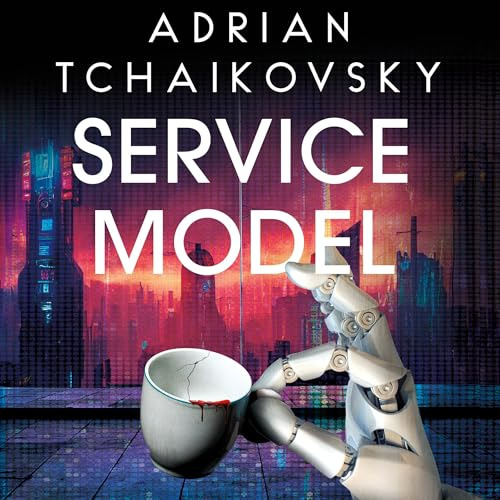
View On WordPress
#Adrian Tchaikovsky#artificial intelligence#Audiobook#Book review#Dystopia#Humorous sci-fi#robots#Science Fiction#Service Model
0 notes
Text
Intelligent Automation ROI: Maximizing Your Investment
Intelligent automation is rapidly transforming how organizations operate. By automating repetitive tasks and leveraging artificial intelligence, businesses can unlock significant improvements in efficiency, productivity, and decision-making. However, measuring the return on investment for intelligent automation initiatives can be a challenge. This blog dives into the world of intelligent automation ROI, exploring the key benefits of these solutions and practical strategies to maximize your investment.

Benefits of Intelligent Automation Solutions
Intelligent automation solutions offer a plethora of advantages that empower businesses to thrive in today’s dynamic market. Let’s delve into some of the key benefits that can significantly impact your organization’s performance:
Reduced Costs & Errors
Cost Savings: Automating tasks translates to reduced labor costs associated with manual processes. Additionally, intelligent automation can minimize the need for additional staff as business volume increases.
Minimized Errors: Human error is a natural part of any manual process. Intelligent automation, however, reduces the risk of errors by following pre-defined rules and eliminating human intervention in data entry and manipulation. This leads to improved accuracy and consistency.
Enhanced Compliance: Intelligent automation can be instrumental in ensuring adherence to regulations and compliance standards. By automating routine tasks and controls, businesses can minimize the risk of non-compliance and associated penalties.
Increased Efficiency & Productivity
Automating Repetitive Tasks: Intelligent automation tackles repetitive, rule-based tasks that often bog down employees. This frees up your workforce to focus on higher-value activities that require creativity, critical thinking, and strategic planning.
Streamlined Workflows: Automation helps streamline complex workflows by seamlessly integrating tasks and eliminating manual data entry. This reduces processing times and allows for faster completion of projects.
Improved Resource Allocation: By automating routine tasks, intelligent automation allows for a more efficient allocation of resources. Employees can be redeployed to areas where their skills and expertise can be better utilized, leading to a more optimized workforce.
Improved Customer Experience
Faster Response Times: Automation enables businesses to respond to customer inquiries and requests promptly. This leads to higher customer satisfaction and loyalty.
24/7 Availability: Intelligent automation solutions can operate around the clock, providing customers with access to services and information at their convenience.
Personalized Interactions: Automation can be leveraged to personalize the customer experience by tailoring interactions based on individual customer preferences and past behavior.
Enhanced Decision-Making
Data-Driven Insights: Intelligent automation facilitates the collection and analysis of vast amounts of data. This empowers businesses to make data-driven decisions that are more informed and strategic.
Predictive Analytics: By leveraging machine learning capabilities, intelligent automation can identify trends and patterns in data, enabling businesses to predict future outcomes and proactively address potential issues.
Improved Risk Management: Intelligent automation can be used to assess and mitigate risks associated with various business processes. This allows for better decision-making and risk management strategies.
Scalability and Agility
Adaptable to Growth: Intelligent automation solutions are inherently scalable. As your business grows and your needs evolve, automation systems can be easily adapted to accommodate the increased workload and changing requirements.
Increased Agility: Automation empowers businesses to respond quickly to market changes and customer demands. By automating routine tasks, organizations can free up resources to focus on innovation and adapting to new market trends.
Improved Collaboration: Intelligent automation can facilitate collaboration between teams and departments by streamlining workflows and communication processes. This leads to a more agile and responsive organization.
Maximizing ROI in Intelligent Automation
Intelligent Automation Services offers a wealth of benefits, but ensuring you see a strong return on investment (ROI) requires a strategic approach. Here are key strategies to maximize the ROI of your intelligent automation initiatives:
1. Careful Process Selection (Process Selection for Automation):
Focus on repetitive, rule-based tasks with high volume and low complexity. These tasks are prime candidates for automation as they can be easily replicated and standardized by intelligent automation services. Examples include data entry, invoice processing, and customer service inquiries.
Identify processes with bottlenecks that are hindering efficiency and productivity. Automating these bottlenecks can significantly improve overall workflow speed.
Consider the cost-benefit analysis of automation. While some tasks might seem repetitive, the cost of automation may outweigh the potential gains. Analyze the time and resources saved through automation compared to the investment required.
2. Scalable Solutions (Scalable Intelligent Automation):
Choose intelligent automation solutions that can adapt and grow alongside your business needs. As your organization expands and processes evolve, you don’t want to be locked into a rigid system. Look for solutions with modular architecture that allows for easy integration of new functionalities.
Consider cloud-based solutions that offer inherent scalability. Cloud platforms can automatically adjust resources based on your workload, ensuring optimal performance and cost-efficiency.
Plan for future growth when selecting your intelligent automation solution. Don’t just focus on solving current challenges; consider how the system can accommodate future requirements and expand its capabilities as needed.
3. Effective Change Management (Change Management in Automation):
Employee buy-in is critical for the success of any automation initiative. Communicate clearly with your workforce about the benefits of automation and how it will impact their roles.
Address employee concerns proactively. Some employees might fear job losses due to automation. Emphasize how automation will free them from tedious tasks and allow them to focus on higher-value activities that require human expertise.
Provide training and support to ensure a smooth transition for your employees. Equip them with the skills and knowledge necessary to work effectively alongside intelligent automation services.
4. Data & Analytics Integration (Data Analytics for Automation ROI):
Leverage data to track the progress and measure the success of your intelligent automation initiatives. Monitor key metrics such as process completion times, error rates, and cost savings.
Use data analytics to identify areas for further improvement. By analyzing automation performance data, you can identify potential bottlenecks and refine your automation strategy to maximize efficiency and ROI.
Invest in business intelligence (BI) tools that provide real-time insights into your automation processes. This data-driven approach allows you to make informed decisions about optimizing your automation strategy for continued ROI.
5. Continuous Improvement (Continuous Improvement in Automation):
Monitor performance on an ongoing basis. Don’t assume that once automation is implemented, the work is done. Regularly evaluate the effectiveness of your automation solutions and identify opportunities for further optimization.
Embrace a culture of continuous improvement. As your business evolves and automation processes mature, there will always be opportunities to refine and enhance them.
Stay informed about the latest advancements in intelligent automation technology. As the field continues to develop, new capabilities and solutions may emerge that can further improve your ROI.
It is by implementing these strategies, that you can ensure that your intelligent automation investments deliver the maximum return, enabling your business to reap the full benefits of this powerful technology.
Charter Global: Your Intelligent Automation Partner for Maximum ROI
At Charter Global, we are a leading provider of Intelligent Automation Services designed to empower businesses to achieve operational excellence. We take a comprehensive approach to intelligent automation, leveraging a powerful combination of Robotic Process Automation (RPA) and Artificial Intelligence (AI) technologies.
RPA automates repetitive, rule-based tasks, freeing up your workforce to focus on higher-value activities. AI enhances automation capabilities by enabling intelligent decision-making, pattern recognition, and continuous learning. This combined approach ensures the most efficient and effective automation solutions for your unique business needs.
Maximizing Your ROI is Our Priority
Our team of experts works closely with you to identify the optimal automation opportunities within your organization. We prioritize careful process selection, scalable solutions, and effective change management to ensure a smooth transition and measurable results.
Data-driven insights are at the core of our approach. We leverage advanced analytics to track automation performance and continuously refine your strategy for maximum ROI.
Discover the transformative power of intelligent automation today. Contact Charter Global to discuss your specific automation needs and explore how we can help you achieve your business goals.
Book your Consultation now!
#Intelligent Automation#Robotic Process Automation (RPA)#Artificial Intelligence (AI) technologies#intelligent automation services
0 notes
Text
The Future of Service Robots in Society - Relay Robotics
Robots are becoming a more essential part of our daily lives as technology develops. Our lives, workplaces, and social interactions are being revolutionized by service robots, which are made to carry out human-beneficial jobs. With advancements driven by leading Service Robot Companies, these robots have the potential to completely transform industries such as healthcare, education, hospitality, and household tasks.
Current Applications of Service Robots
Service robots are already making a significant impact in various sectors. In healthcare, robots like Robear and RIBA assist nurses in lifting and moving patients, reducing the risk of injuries. Educational robots, such as Dash and Dot, engage children in interactive learning experiences, enhancing their cognitive skills. In the hospitality industry, robots like Relay and Pepper provide customer service, streamlining check-in processes and improving guest experiences. Domestic robots, like Roomba and Neato, simplify household chores, freeing up time for more leisure activities.

Emerging Trends in Service Robotics, Glimpse into the Future
Several emerging trends will shape the future of service robots:
Artificial Intelligence (AI): Advancements in AI will enable robots to learn from experience, adapt to new situations, and interact more naturally with humans.
Internet of Things (IoT): Integration with IoT devices will allow robots to seamlessly interact with smart home systems, enhancing their functionality.
Human-Robot Interaction (HRI): Improved HRI will facilitate more intuitive communication between humans and robots.
Autonomous Navigation: Robots will become increasingly adept at navigating complex environments, reducing the need for human intervention.
Future Possibilities for Exploring the Role of Service Robots
As service robots continue to evolve, we can expect:
Personal Assistant Robots: Robots will become personalized companions, assisting individuals with daily tasks, scheduling, and health monitoring.
Elderly Care: Robots will provide critical support for aging populations, offering mobility assistance, medication reminders, and social interaction.
Disaster Response: Robots will play a vital role in search and rescue operations, navigating hazardous environments and providing critical aid.
Environmental Sustainability: Robots will help monitor and mitigate environmental issues, such as pollution and climate change.
Challenges and Concerns in The Integrations
While service robots hold tremendous potential, there are challenges to address:
Job Displacement: The automation of tasks may lead to job losses in certain sectors.
Safety and Security: Ensuring robot safety and preventing potential hacking or data breaches is crucial.
Ethics and Responsibility: Establishing guidelines for robot decision-making and accountability is essential.
Social Acceptance: Overcoming social and cultural barriers to robot adoption will require education and awareness.
Closing Remarks
The future of service robots in society is promising, with potential applications across various industries. As technology advances, we must address the challenges and concerns associated with robot integration. By embracing the benefits of service robots, we can create a more efficient, productive, and compassionate society. Relay Robotics is leading the way in transforming industries with cutting-edge robotic solutions. Discover how our innovative service robots can enhance your business operations — visit us today and explore the future of automation.
#Service Robots#Artificial Intelligence#Internet of Things#Human-Robot Interaction#Robotics#Future Technology
0 notes
Text
Top 5 Tips for Learning IoT and AI

As we navigate the evolving landscapes of IoT and AI, it’s essential we establish a strong foundation in programming languages like Python and Java. Engaging in hands-on projects not only solidifies our understanding but also bridges the gap between theory and practice. By connecting with online communities, we can share insights and resources that enhance our learning. However, staying updated on industry trends and exploring real-world case studies are equally crucial. So, what are the specific strategies we can employ to maximize our efforts in these areas?
Build a Strong Programming Foundation

While we dive into the realms of IoT and AI, it’s crucial to build a strong programming foundation. Having solid programming skills not only aids in understanding complex algorithms but also equips us to handle data effectively. We should start by mastering languages like Python and Java, as they’re widely used in both fields.
Data analysis is equally important, so familiarizing ourselves with libraries like Pandas and NumPy will enhance our ability to manipulate and interpret data.
Next, we need to define clear objectives for our projects. Establishing SMART goals helps us stay focused and measure our progress. Identifying relevant data sources is essential too—both internal and external—ensuring we gather high-quality data for training AI models.
As we collect data, let’s pay attention to cleaning and preprocessing techniques, as these steps significantly impact the performance of our models.
Lastly, we should engage with online communities and forums. Collaborating with peers not only enriches our learning experience but also exposes us to diverse perspectives.
Engage in Hands-On Projects

Engaging in hands-on projects is one of the most effective ways to deepen our understanding of IoT and AI. By applying theoretical knowledge, we can see how these concepts play out in real-world scenarios.
Let’s start by building small projects that incorporate IoT devices, like using sensors to track environmental conditions or automating tasks within our homes. This practical application helps us grasp the mechanics behind these technologies.
As we progress, we can explore more complex setups, such as creating smart classrooms. Imagine using IoT-enabled projectors and interactive whiteboards to enhance collaborative learning. These projects not only solidify our skills but also demonstrate the power of IoT in educational environments.
Moreover, we shouldn’t shy away from experimenting with AI algorithms. By developing simple machine learning models, we can analyze data and gain insights into how AI interprets information. This hands-on experience encourages creativity and problem-solving, essential skills in this evolving field.
Ultimately, engaging in hands-on projects empowers us to bridge the gap between theory and practice, making our journey in IoT and AI both exciting and impactful.
Let’s dive in and start building!
Join Online Communities

In today’s digital age, joining online communities can significantly enhance our learning experience in IoT and AI. These platforms provide exclusive access to structured courses and resources that cater to our specific learning needs.
We can participate in live learning sessions with top educators, allowing us to interact directly with experts and fellow learners.
Networking opportunities abound within these communities. We can connect with diverse individuals who share our interests, fostering collaboration and support.
Engaging in discussions and exclusive chat groups enriches our understanding and exposes us to different perspectives, greatly benefiting our learning journey.
Moreover, many online communities offer certification upon course completion, which we can showcase on platforms like LinkedIn. This recognition enhances our professional credibility and supports our career advancement.
Stay Updated on Trends

Staying on top of trends in IoT and AI is essential for anyone looking to thrive in these rapidly evolving fields. We need to recognize the staggering growth projections, like the IoT market reaching $650 billion by 2026 and the expected 30.9 billion active IoT devices. This rapid expansion means we must continuously educate ourselves about emerging technologies and industry shifts.
We should pay attention to key trends, such as the ongoing chip shortage impacting IoT investments, with many semiconductor executives predicting supply chain improvements. Additionally, as IoT devices proliferate, security becomes a pressing concern. Staying informed about new regulations and security measures will help us navigate this landscape effectively.
We must also explore how AI is increasingly intertwined with IoT, providing real-time insights and enhancing decision-making across various sectors. By keeping up with research, attending webinars, and reading relevant publications, we can ensure our knowledge remains current and applicable.
In this way, we can position ourselves not just as learners but as informed participants ready to seize opportunities in the dynamic fields of IoT and AI.
Explore Real-World Case Studies

Exploring real-world case studies offers us valuable insights into how IoT and AI technologies are transforming various industries. For example, the iRobot Roomba uses AI to efficiently map home layouts and optimize cleaning patterns. This innovation, first launched in 2002, paved the way for widespread consumer adoption of smart home devices.
Similarly, Nest Labs’ smart thermostat learns user preferences, adjusting energy use accordingly, and showcases AI’s impact on energy efficiency.
In the automotive sector, Tesla’s self-driving technology employs machine learning to predict driver behavior based on extensive road data, demonstrating the potential of AI in transportation.
Additionally, companies like Kairos are leveraging AI for marketing insights, serving high-profile clients like Nike and IBM.
As we delve into these applications, we also need to consider the ethical implications, especially concerning privacy and security with technologies like facial recognition.
Frequently Asked Questions
How to Learn AI and Iot?
To learn AI and IoT effectively, we should focus on programming and data analysis. Let’s engage in hands-on projects, join communities, and stay updated on trends to deepen our understanding and practical skills.
Which Is Better to Learn Iot or Ai?
When deciding between IoT and AI, we should consider our interests. If we enjoy hardware and connectivity, IoT’s practical applications might excite us. If data analysis fascinates us, AI’s predictive capabilities could be more appealing.
How Can AI Be Used in Iot?
AI enhances IoT by enabling smart devices to make real-time decisions, learn patterns, and automate tasks. Together, they improve efficiency and responsiveness in various sectors, transforming how we interact with technology daily.
Which Is Better, Aith or Ai?
When we compare AI and AIth, it’s clear that AIth offers greater integration by combining AI’s capabilities with IoT. This synergy allows for smarter decision-making and enhanced efficiency in real-world applications.
Conclusion
In conclusion, mastering IoT and AI starts with a solid programming foundation and practical experience. By diving into hands-on projects, we can truly grasp these technologies. Connecting with online communities keeps us informed and inspired, while staying updated on industry trends ensures we remain relevant. Finally, exploring real-world case studies helps us understand the ethical implications of our work. Let’s embrace this journey together and unlock the potential of IoT and AI!
How Zekatix Helps You on the Journey
Zekatix is here to make your journey into IoT and AI smoother, combining all the steps essential for mastering these technologies. With courses that build your programming foundation, hands-on project resources, and insightful case studies, Zekatix equips you with everything you need to grow. Our platform connects learners to active online communities, keeping you updated on the latest trends and innovations in IoT and AI. As you explore these rapidly evolving fields, Zekatix serves as your partner in learning and innovation, helping you thrive in tech. Join today and take the next leap toward mastering the future of technology!
Sign up for free courses here. Visit Zekatix for more information.
Sign up for free courses here.
Visit Zekatix for more information.
#edtech company#courses#embedded systems#nanotechnology#artificial intelligence#embeded#academics#online courses#robotics#zekatix#AI#IOT#iotsolutions#iot applications#iot development services#innovation#embedded#iot platform#techinnovation
0 notes
Text
0 notes
Text
Pavlo Pikulin, Founder & CEO of Deus Robotics – Interview Series
New Post has been published on https://thedigitalinsider.com/pavlo-pikulin-founder-ceo-of-deus-robotics-interview-series/
Pavlo Pikulin, Founder & CEO of Deus Robotics – Interview Series
Pavlo Pikulin is the founder and CEO of Deus Robotics, which has developed an AI platform that connects and enhances the intelligence of warehouse robots from any manufacturer. The company also offers AI-powered robots that cover 90% of warehouse automation needs — and counting. With over 22 years of experience in AI and 6 years in robotics, Pavlo serves as an Expert on the Artificial Intelligence committee under Ukraine’s Ministry of Digital Transformation.
Can you share your journey in AI and robotics, and what inspired you to start Deus Robotics?
It all began with my dad, who’s always been a tech enthusiast. Even before I was born, he got me a personal computer — pretty rare in my hometown back in 1989.
When I was five, I wrote my first computer program. The idea of giving a task to a machine and watching it execute was absolutely fascinating to me.
At seven, I sold my first website for $20. Soon after, I started building and selling computers. By thirteen, I had written a program to bypass a captcha in a computer game, which later evolved into an automatic number-plate recognition system.
By fifteen, I was convinced that the future was all about robotics.
This realization set my path towards robotics and AI. However, at that age, I didn’t have the means to start my own robotics company, so I took a bit of a detour. At nineteen, I launched a game studio which grew into a global company with 60 million users worldwide. By 2021, we had 700 employees, and some of our games became the top downloads in their genre in the US.
But robotics was always on my mind and in my heart. I’ve always believed the world would be better if robots could handle all the tough, mundane, or dangerous tasks. By late 2017, I had saved enough to finally bootstrap my own robotics company and make that vision a reality.
It took me a year to do all the research in robotics I needed to start. After that, I gathered a team of incredibly talented engineers and programmers — some old friends, others new faces — and we launched Deus Robotics in early 2019. This past summer, Deus Robotics was shortlisted for Logistics UK’s Logistics Awards, Robotics & Automation Awards, and Supply Chain Excellence Awards USA.
What lessons did you carry over from your 15 years in the gaming industry to robotics and AI?
Working on games has given me valuable experience in many key areas, and it’s been rewarding to see how these skills apply to robotics.
Virtual Worlds for Robotics
Virtual worlds are a game-changer in robotics, offering a quicker and more efficient way to test ideas without waiting months for a hardware prototype. Instead of spending time and resources on physical prototypes, you can experiment in a virtual environment. Creating these virtual worlds is a lot like designing a game, where robots interact with their surroundings — this is where my game development experience really comes in handy.
Algorithm Transfer
When we were developing algorithms for robot path planning, as a team, we tapped into our experience from creating similar algorithms in games for character navigation. In our strategy games, hundreds of characters had to navigate through cities with roads and buildings — just like robots in our systems. This made transferring our path-planning expertise to robotics feel seamless and natural.
Complex Software and Analytics
Robots, much like games, are built on complex software. Developing a world-class game involves creating secure payment systems, social features like chat and groups, competitive elements, and a detailed virtual world with countless mechanics. One of our games had over 300 functional windows — more than you’d find in most banking apps! Games also handle massive loads, with millions or even billions of users performing countless actions, and this experience provides valuable insights for warehouse robotics.
Another crucial aspect is analytics. In games, we had to quickly and efficiently analyze user actions, managing high volumes of data. The same is true for robots, which continuously send vast amounts of data that need robust processing and analysis systems. Additionally, creating AI agents in games to engage players is similar to programming robots, as both involve crafting intelligent, responsive behavior.
In short, if you can build and manage a game development team, you’ve got what it takes to lead a robotics team as well.
How has your role in the Artificial Intelligence Committee under Ukraine’s Ministry of Digital Transformation influenced your work at Deus Robotics?
The Committee’s goal is to advise government authorities on AI, including robotics. I joined to provide expertise specifically in robotics and to consult on government requests. We’re also focused on education, regulations, and pilot AI projects in Ukraine.
Through my work with the Committee, Deus Robotics found a way to expand our passion for advancing robotics in Ukraine beyond just warehouse automation. This allows us to make a broader impact.
Could you explain the unique AI brain developed by Deus Robotics and how it enhances the intelligence of warehouse robots?
Our robot control software, dubbed AI brain, includes key technologies:
1. On-Robot Systems:
A system that collects and analyzes data from all the robot’s sensors, helping it understand its surroundings, determine its location, and make decisions.
A control system that manages all robot mechanisms, such as manipulators, motors, lidars, and cameras, to execute the robot’s decisions.
A 3D recognition system that identifies obstacles using 3D cameras and a lidar recognition system that interprets what the LIDAR detects.
2. Centralized Management Platform:
Our AI platform connects all robots via Wi-Fi, coordinating their actions and enabling centralized communication.
In warehouses, our centralized system is crucial. It prevents collisions by tracking each robot’s exact location in real-time, allowing them to move quickly and safely.
This centralized system also integrates seamlessly with the warehouse management system, making it a key advantage and streamlining robot management.
Besides being connected, our robots are also getting smarter. Thanks to the adapters for different robots, our system can integrate robots from various manufacturers, enabling them to share information and coordinate tasks.
Previously, robots could only coordinate with other robots from the same manufacturer. Now, they can exchange data and work together across different brands.
What sets Deus Robotics apart from other companies in the warehouse automation industry?
Unlike other warehouse robotics companies, we’ve developed the heart of what makes robots truly effective: their brain. Our AI-powered brain connects with robots from any manufacturer, including our own, turning even the simplest robots into smarter, more capable machines. This kind of interoperability is something special in the industry.
This is especially important because, typically, robots from different manufacturers don’t play well together. Each robotics provider only covers a small slice of automation needs, leaving warehouses to choose from too many options. Each provider also requires costly and time-consuming integration, making it hard to switch if you want to try something new. Plus, when robots from different providers can’t connect or be centrally managed, it complicates operations and limits your ability to scale.
That’s where we come in. Our system makes it easy to bring as many robots as you need under one roof, all managed through a single, user-friendly platform.
With our solution, you get:
All automation needs covered under one system.
A single integration for all current and future providers, eliminating repeated integration costs and allowing you to switch providers as needed.
An easy-to-use management system for all current and future robots.
AI-enhanced, smarter robots that work together seamlessly (what’s important, our system can connect with humanoids, too).
Ongoing training and support for warehouse operators to ensure smooth operations.
And the best part? Our solution is truly all-in-one. We offer robots that tackle 90% of logistics tasks (and counting), paired with our AI platform that ties everything together. With our system, you can easily connect robots from any provider, simplify your operations, and scale your automation like never before. This is particularly important as only 20% of warehouses are automated.
How does Lidar technology enhance the navigation capabilities of your AGVs compared to traditional methods?
When our robot spots a floor tag, it navigates with pinpoint accuracy — within 1mm. But when the tag isn’t in view, accuracy can drop to around 20mm. That’s where LIDAR comes in, helping to keep navigation precise even between markers.
LIDAR adds another layer of information, which we combine with data from tags and gyroscopes. Each source gives us different insights with varying accuracy. Our specialized system merges all these inputs to pinpoint the robot’s position with high precision. The more accurate the data, the better the robot navigates, and precise positioning is key to smooth and effective robot movement.
Could you describe the role and benefits of your Robot as a Service (RaaS) and Software as a Service (SaaS) models for businesses?
Buying robots requires significant capital investment, leading to a payback period of one to three years. This also ties up the client’s operating funds and increases capital expenses.
RaaS (Robots as a Service) is a game-changer for businesses. It eliminates the need for capital investment, relying instead on operational expenses. The payback begins in the first month, thanks to the immediate boost in productivity. Instead of needing 2-5 times more people to achieve the same productivity, robots enhance the efficiency of existing staff—at a lower cost than hiring additional workers.
Plus, RaaS reduces risk. There’s no need to freeze investments, and expenses shift from CAPEX to OPEX.
What are the advantages of QR Code Navigation in AGVs, and how does it compare to Lidar?
Automated guided vehicles (AGVs) follow fixed routes, navigating via floor tags instead of LIDAR, and can’t deviate from their path. In contrast, our autonomous mobile robots (AMRs) use 3D LIDAR scans for flexible navigation without relying on floor markers.
In what ways do Deus Robotics’ solutions address the current challenges faced by warehouse logistics and the 3PL industry?
Currently, we offer a solution that transports goods from point A to point B, which is especially appealing to fulfillment centers. However, the need to move goods exists in any warehouse — whether it’s in manufacturing, healthcare, automotive, or retail. In the future, we plan to expand our product line to include robots that can handle tasks like packing, loading and unloading trucks, unpacking, and picking. We’re already working closely with robot manufacturers to integrate their products into our lineup.
Another challenge we’re addressing to make warehouses more efficient is providing a unified system for managing robots — a single integration, management, and enhancement point. Our clients don’t need to deal with multiple robot platforms. They only need to integrate with us once and can then use any robots they choose. While our current selection of robots is limited (we have 15 models to date), we’re constantly working to expand it.
What advancements do you foresee in the integration of AI and robotics in warehouse automation over the next 5-10 years?
One of the biggest challenges we face is figuring out the best way to automate each warehouse. Even though warehouses perform similar tasks, they differ in the details — like processes, staff, the types of goods they handle, and their goals. Some aim for maximum efficiency, others for cost-effectiveness. Planning the right automation solution and setting up the best business processes takes a lot of time and effort from experts. I’m convinced that AI will soon help us design warehouse automation in just seconds, making the process much smoother and more efficient.
Another exciting development is the rise of specialized robots designed for specific tasks. While the first robots were built for general use, as automation grows, we’ll see more robots tailored to unique needs. For example, inventory robots are just starting to appear since most warehouses only need one or two.
Humanoid robots are also on the horizon. These versatile robots will be able to handle tasks much like humans, thanks to advances in AI.
AI is also getting better at helping people with their tasks, like smarter voice assistants that can offer guidance. Plus, AI can optimize warehouse operations by analyzing data and improving efficiency. With access to digital warehouse data, AI can quickly identify and fix issues, making everything run more smoothly.
Looking at the bigger picture, AI will also improve how different warehouses work together, along with suppliers and logistics partners. This includes better scheduling, moving goods efficiently, and predicting what will be needed next.
All in all, AI and robotics are not just tools for automation — they’re the keys to unlocking a smarter, more connected future for warehouses and beyond.
Thank you for the great interview, readers who wish to learn more should visit Deus Robotics.
#3d#agents#ai#AI AGENTS#ai platform#AI-powered#algorithm#Algorithms#amp#Analysis#Analytics#apps#artificial#Artificial Intelligence#as a service#automation#automotive#autonomous#autonomous mobile robots#banking#Behavior#Bootstrap#Born#Brain#brands#Building#buildings#Business#Cameras#CEO
0 notes